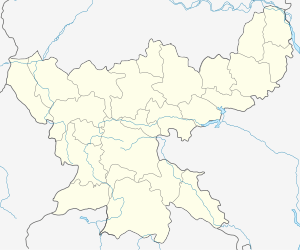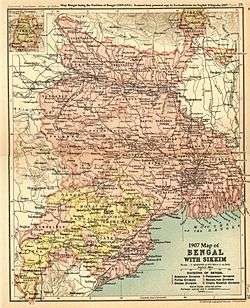Rajmahal
Rajmahal is a subdivision and a notified area in Sahibganj district in the Indian state of Jharkhand. It is situated at the banks of Ganges and was former capital of Bengal Subah under Mughal governor, Man Singh I.
Rajmahal | |
|---|---|
town | |
 Rajmahal Location in Jharkhand, India  Rajmahal Rajmahal (India) | |
| Coordinates: 25.05°N 87.84°E | |
| Country | |
| State | Jharkhand |
| District | Sahibganj |
| Population (2011) | |
| • Total | 22,514 |
| Languages | |
| • Official | Hindi, Bengali, Santhali |
| Time zone | UTC+5:30 (IST) |
| Vehicle registration | JH |
History

Rajmahal region was earlier ruled by Raja Mal sub-group of Mal Paharia tribes. Earlier this place was known as "Agmahal" and is surrounded by Rajmahal hills on one side and river Ganges on another side. The region was also known as 'Daman-i-Koh' during Mughal rule.
In 1576, Battle of Rajmahal was fought between Mughal Emperor, Akbar and Sultan of Bengal, Daud Khan Karrani of Karrani Dynasty. After war, Daud Khan was captured and later executed by the Mughals.
Later, after the conquest of Odisha in 1592, Raja Man Singh I, Mughal governor of Bengal Subah came at Rajmahal. He chose the site for his capital in 1595–96 because of its strategic command of the Teliagarhi Pass and the Ganges River. In 1608, the capital of Bengal was transferred to Dacca (now Dhaka, Bangladesh). Raja Man Singh I, also renamed the town as 'Akbarnagar' in to tribute to Emperor Akbar and he also constructed palace, garden and mosque on behalf of Mughal rulers.
In 1639, Rajmahal regained its glory and was once more made the capital of Bengal by Shah Shuja, governor of Bengal Subah and second son of Emperor Shah Jahan. It continued as the seat of the Mughal Viceroy up to 1660 and a mint town till 1661.
In 1757, Battle of Plassey was fought between Robert Clive and Nawab of Bengal, Siraj-ud-Daulah where Nawab lost the war due to treachery of Mir Jafar and he fled from Murshidabad towards Patna. During his halt at Rajmahal, Siraj-ud-Daulah was captured by Mir Jafar's son Miran and was murdered at the site.[1]
Battle of Udhwa nala at Rajmahal was fought between Mir Qasim, and Britosh in 1763. Nawab Mir Qasim was defeated by the British and fled with his family to the Rohtas (Bihar), but was not able to hide at the Rohtasgarh Fort.
During British rule, Permanent Settlement was passed in 1793 and it forced the landlords to improve productivity of the land. The Santals were increasingly used for land reclamation and improvement and further Santals got permanently settled in the region. British also constructed Neel-Kothi for process and storage of Neel (Indigo) which was used for dying cotton cloth.[2]
Later, Daman-i-Koh became the origin of Santhal Rebellion and leaders like Sidhu and Kanhu Murmu, Chand and Bhairab,etc and they fought against the British colonial authority and the corrupt zamindari system mobilizing more than 10,000 Santhals.
Geology
Plant Fossil bearing Inter-trappean beds of Rajmahal Formation nearby has been declared the National Geological Monuments of India by the Geological Survey of India (GSI), for their protection, maintenance, promotion and enhancement of geotourism.[3][4][5]
Demographics
As of 2011 India census, Rajmahal had a population of 22,514. Males constitute 52% of the population and females 48%. Rajmahal has an average literacy rate of 62.70%, lower than the national average of 74.04%: male literacy is 68.73%, and female literacy is 56.06%. In Rajmahal, 19% of the population is under 6 years of age.
Tourist Attractions
- Teliagarhi Fort, It was built by family of Teli Zamindar before Islamic rule in the region. Teliagarhi is also called 'Ancient Gateway of Bengal'.[6]
- The Jami Mosque, built in reign of Emperor Akbar at Mangalhat
- Baradari, build by Fateh Jung khan, a wealthy zamindar of Bengal. Half of the structure was bombed by Mughal governor, Man Singh.
- Akbari Mosque built in 1556 by Mughal governor, Man Singh I
- Palace of Shah Shuja, consists Singhi Dalan, a marble pavilion facing the river Ganges[7]
- Palace of Mīr Qasīm, Nawab of Bengal.
- Tomb of Maina-Bibi, built in 1779. Historian H.M Qureshi has identified the tomb with Munni Begum, who was a Begum of the harem of Nawab Mir Jaffer of Bengal
- Tomb of Miran, son of Mir Jafar, Nawab of Bengal
- Neel Kothi, built by British
- Taksal of Jagat Seth, earlier Nawab of Bengal
- Kanhaiyasthan, It is believed that the place is visited by Chaitanya Mahaprabhu
- Shivgadi, a cave temple of Hindu god, Shiva
- Bhoganadih, the place where Santhal Rebellion initiated, a monument is also erected on the place and every year Shaheed Mela is organised
- Moti Jharna waterfalls
- Udhwa Bird Sanctuary
Administration
Assembly segments
Presently, Rajmahal Lok Sabha constituency comprises the following six Vidhan Sabha (legislative assembly) segments:[8]
| Constituency number | Name | Reserved for (SC/ST/None) | District |
|---|---|---|---|
| 1 | Rajmahal | None | Sahebganj |
| 2 | Borio | ST | Sahebganj |
| 3 | Barhait | ST | Sahebganj |
| 4 | Litipara | ST | Pakur |
| 5 | Pakaur | None | Pakur |
| 6 | Maheshpur | ST | Pakur |
Members of Parliament
The Rajmahal (Lok Sabha constituency) is centered around the city and Vijay Kumar Hansdak is the M.P of the region from Jharkhand Mukti Morch.
Notes
- "Battle of Plassey: God Fought for Great Britain". Probashi. 19 April 2015. Retrieved 25 April 2020.
- Sarkar, Jadunath (1984). A History of Jaipur, c. 1503-1938, New Delhi: Orient Longman, ISBN 81-250-0333-9, p.81
- National Geological Monument, from Geological Survey of India website
- "Geo-Heritage Sites". pib.nic.in. Press Information Bureau. 9 March 2016. Retrieved 15 September 2018.
- national geo-heritage of India, INTACH
- Verma, Brajesh (8 June 2018). "Ancient Gateway of Bengal: Teliagadhi of Jharkhand". Border News. Retrieved 25 April 2020.
- "Intach aid for Mughal monuments". www.telegraphindia.com. Retrieved 25 April 2020.
- "Parliamentary Constituency". Chief Electoral Officer, Jharkhand website. Archived from the original on 26 February 2012.
